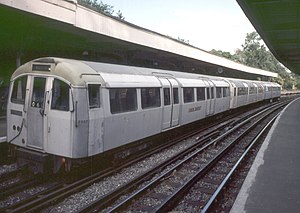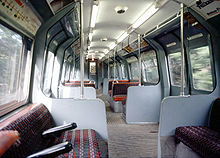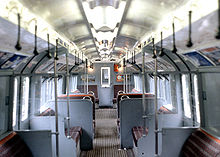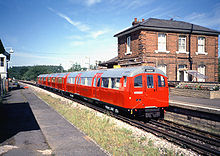
The Central line is a London Underground line that runs through central London, from Epping, Essex, in the north-east to Ealing Broadway and West Ruislip in west London. Printed in red on the Tube map, the line serves 49 stations over 46 miles (74 km), making it the longest line on the Underground. It is one of only two lines on the Underground network to cross the Greater London boundary, the other being the Metropolitan line. One of London's deep-level railways, Central line trains are smaller than those on British main lines.
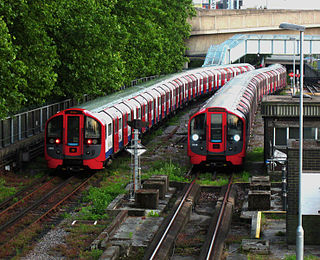
London Underground rolling stock includes the electric multiple-unit trains used on the London Underground. These come in two sizes, smaller deep-level tube trains and larger sub-surface trains of a similar size to those on British main lines, both running on standard gauge tracks. New trains are designed for the maximum number of standing passengers and for speed of access to the cars.

The London Underground 1938 Stock was a London Underground tube stock design. A total of 1,121 cars were built by Metro-Cammell and Birmingham RC&W. An additional 173 cars were added to the fleet by the end of 1953, comprising 91 new builds, 76 conversions from Pre-1938 Tube Stock or 1935 Tube Stock, and six unconverted cars of 1935 Tube Stock, and the stock was used on the London Underground until 1988. During their long lives they worked on the Bakerloo, Northern, Piccadilly, East London, Central, and Northern City lines. Ten sets were refurbished and ran on the Isle of Wight as Class 483, making them the oldest passenger rolling stock operating timetabled services on the National Rail network at the time of their withdrawal in January 2021. The trains represented a major technical advance, as all the electrical equipment was located under the floor for the first time. All previous tube stock had large equipment compartments behind the driving cabs in motor cars, which reduced the space available for passengers by about a third.

The Standard Stock title was applied to a variety of Tube stock built between 1923 and 1934, all of which shared the same basic characteristics, but with some detailed differences. This design is sometimes referred to as 1923 Tube Stock, 1923 Stock, or Pre 1938 Stock. Most of the Standard Stock was built to replace the first generation of "Gate Stock" Tube trains or to provide additional trains for extensions built in the 1920s and early 1930s. Standard Stock cars consisted of motor cars, with a driver's cab, behind which was a "switch compartment" occupying approximately one-third of the length of the car, plus trailer cars and "control trailers", with a driving cab but no motor. All were equipped with air operated sliding doors. The guard's door on the earlier trains was a manually operated, inward-opening hinged door.

The London Underground R Stock electric multiple units were used on London Underground's District line from 1949 to 1983. Composed of new cars and converted Q38 Stock trailers, the cars were built and converted in three batches between 1949 and 1959. The cars were driving motors (DM) or non-driving motors (NDM), there being no unpowered trailers. The second batch, introduced in 1952, was constructed from aluminium, saving weight and one train was left unpainted as an experiment. Considered a success, trains were left unpainted or painted white or grey to match in 1963–68. Originally designed to operate in trains with six off-peak and eight cars during peak hours, the trains were reformed as fixed seven-car trains in 1971. R Stock trains were replaced by the D78 Stock and withdrawn between 1981 and 1983.

The London Underground O and P Stock electric multiple units were used on the London Underground from 1937 to 1981. O Stock trains were built for the Hammersmith & City line, using metadyne control equipment with regenerative braking, but the trains were made up entirely of motor cars and this caused technical problems with the traction supply so trailer cars were added. P Stock cars were built to run together with the O Stock cars now surplus on Metropolitan line Uxbridge services. The trains had air-operated sliding doors under control of the guard; the O Stock with controls in the cab whereas the P Stock controls in the trailing end of the motor cars. The P Stock was introduced with first class accommodation, but this was withdrawn in 1940.

The London Underground 1967 Stock was a type of deep-level train that operated on the Victoria line of the London Underground from the line's opening on 1 September 1968 until 30 June 2011. It was also used on the Central line between Woodford and Hainault between 21 February 1968 and 1984, as the same automatic train operation (ATO) system was used on both lines.

London Underground battery-electric locomotives are battery locomotives used for hauling engineers' trains on the London Underground network where they can operate when the electric traction current is switched off. The first two locomotives were built in 1905 for the construction of the Great Northern, Piccadilly and Brompton Railway, and their success prompted the District Railway to buy two more in 1909, which were the only ones built to the loading gauge of the subsurface lines. Following this, a number of battery vehicles were built by converting redundant motor cars, with the batteries placed in the unused passenger compartment. One exception to this was made by the City and South London Railway, who used a trailer car to hold the batteries, and wired them to a separate locomotive.

An electric multiple unit (EMU) is an electric self-powered train, capable of operating in multiple with other EMUs and without the need for a locomotive; these are typically passenger trains with accommodation in every vehicle and a driving position at each end. The term can also be used to describe a train that is a permanent formation with a non-driving power car, such as the Advanced Passenger Train. As of December 2010, two-thirds of the passenger carriages in Great Britain are formed in EMUs.
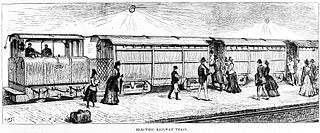
Electric locomotives were first used on the London Underground when the first deep-level tube line, the City and South London Railway (C&SLR), was opened in 1890. The first underground railways in London, the Metropolitan Railway (MR) and the District Railway (DR), used specially built steam locomotives to haul their trains through shallow tunnels which had many ventilation openings to allow steam and smoke to clear from the tunnels. It was impractical to use steam locomotives in the small unvented tubular tunnels of the deep-level lines, and the only options were rope haulage or electric locomotives.
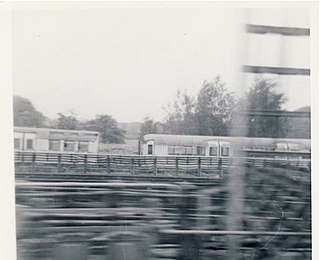
The London Underground 1935 Stock was an experimental train design by Metropolitan Cammell in London. Twelve two-car units, marshalled into four six-car trains, were built. They served as the prototypes for the later 1938 Stock.
The 1920 Tube Stock consisted of forty cars built by Cammell Laird in Nottingham, England. These cars were the first new tube cars to be built with air operated doors. The batch consisted of twenty trailer and twenty control trailer cars, which were formed into six-car trains by the addition of twenty French motor cars built in 1906 and modified for air-door operation. They initially ran on the Piccadilly tube, but in 1930 were considered to be drab, compared to new stock being delivered at the time. The motor cars were therefore replaced by Standard Stock units, built in 1927, and the 1920 cars were refurbished. They were transferred to the Bakerloo line in 1932, and continued to operate until 1938.
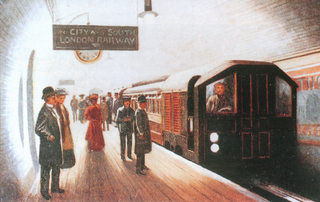
The Central London Railway Stock were electric multiple units composed of trailers that had been converted from carriages designed to be hauled by electric locomotives with new motor cars. The Central London Railway opened in 1900 with electric locomotives hauling wooden carriages, but the heavy locomotives caused vibrations that could be felt in the buildings above the route. It was found that conversion to electric multiple units solved the problem, so new motor cars were bought and replaced all the locomotives by June 1903. Trains normally ran with six-cars, four trailers and two motor-cars. Some trailers were equipped with control equipment to allow trains to be formed with three cars.

The London Underground Q Stock were trains used on the District line of the London Underground. First introduced in 1938, these electric multiple units were formed from cars built between 1923 and 1935 and new purpose-built cars, and fitted with electro-pneumatic brakes and guard controlled air-operated doors. Trains were made up from cars of different ages with differing appearances, the older ones with clerestory roofs and the newer ones with flared sides. Some units were withdrawn in the early 1960s, although six- and eight-car trains remained on the District line with use gradually diminishing to peak hours only, and four car units worked the East London line until 1971.

Metropolitan Railway electric multiple units were used on London's Metropolitan Railway after the lines were electrified in the early 20th century.

District Railway electric multiple units were used on London's Metropolitan District Railway after the lines were electrified in the early 20th century.

Departmental locomotives on the London Underground consist of vehicles of a number of types which are used for engineering purposes. These include battery locomotives, diesel locomotives, electric locomotives, sleet locomotives, pilot motor cars and ballast motor cars. Details of the first four types are covered elsewhere. Pilot motor cars and ballast motor cars are generally vehicles which have been withdrawn from passenger service, but continue to be used by the engineering department. Pilot motor cars are used to move other vehicles around the system, while ballast motor cars are used to haul ballast trains and engineering trains.

Ruislip depot is a London Underground traction maintenance depot on the Central line, and is situated between the stations of Ruislip Gardens and West Ruislip in the London Borough of Hillingdon. The depot is accessible from both ends, and was built for the Central Line extensions under the 1935-1940 New Works Programme. It was nearly completed by 1939, when the outbreak of the Second World War prevented further work. It was used as a factory for anti-aircraft guns during the war, and was finally opened in 1948. The main car shed has 16 tracks, and there is also a three-track car cleaning shed.
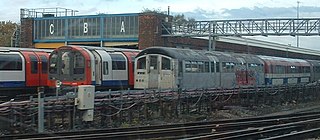
Hainault depot is a traction maintenance depot in Ilford on the London Underground Central line, between Hainault and Grange Hill stations, now in the London Borough of Redbridge, England. Until boundary changes in 1998, part of the depot was in Epping Forest District. Construction began in 1939, but was delayed by the onset of the Second World War, and was not completed until 1948. It has stabled three generations of trains, Standard stock, 1962 stock and 1992 stock. It has also housed trains of the experimental 1960 stock, both when it was conventionally controlled and during trials of Automatic Train Operation (ATO) in preparation for the construction of the Victoria line. Some of the 1967 stock destined for the Victoria line was also stabled at the depot while its ATO equipment was tested and commissioned on the Woodford to Hainault Branch.

Acton Works is a London Underground maintenance facility in West London, England. It is accessed from the District line and Piccadilly line tracks to the east of Acton Town station, and was opened in 1922. It was responsible for the overhaul of rolling stock, and gradually took on this role for more lines, until the formation of the London Passenger Transport Board in 1933, when all major overhauls of underground vehicles were carried out at the works. By 1985, when rolling stock had become more reliable and maintenance intervals had increased, this function was devolved to depots on each line. Subsequently, Acton continued to overhaul major items after they had been removed from trains at the depots, and tendered for work, which included the conversion of the A60 Stock to One Person Operation. It is likely to be reorganised and expanded to house the departments displaced from Lillie Bridge Depot which is being demolished as part of the redevelopment of Earls Court Exhibition Centre.
